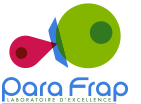-
PARAFRAP
- Qui sommes-nous
- Objectifs du Labex
- Laboratoires de recherches
- Coordinateurs
- Collaborateurs industriels
- Tutelles et soutiens
- GOUVERNANCE
- Organisation
- Comité de pilotage
- Comité exécutif
- Conseil scientifique international
- Comité Institutionnel
- FORMATION
- CONFERENCES
- THÉMATIQUES
- Exploitation des données post génomiques
- Mécanisme de la pathogénie
- Biologie Cellulaire et Moléculaire
- Nouvelles stratégies d'interventions thérapeutiques
- Plateformes
- VALORISATION
-
PARAFRAP
- Qui sommes-nous
- Objectifs du Labex
- Laboratoires de recherches
- Coordinateurs
- Collaborateurs industriels
- Tutelles et soutiens
- GOUVERNANCE
- Organisation
- Comité de pilotage
- Comité exécutif
- Conseil scientifique international
- Comité Institutionnel
- FORMATION

Maryse LEBRUN
Information

Laboratory of Pathogen Host Interactions 
Cell biology of apicomplexan parasites 
Montpellier 
0000-0002-0962-0156 
Cette adresse e-mail est protégée contre les robots spammeurs. Vous devez activer le JavaScript pour la visualiser. 
https://cutt.ly/sw2i2ZC 
@Lebrun43782700 Scientific interests and projects
We are interested in the cellular and molecular mechanisms that enable apicomplexan parasites to infect and develop inside their host. The phylum Apicomplexa comprises single-celled eukaryotic parasites. They are important pathogens of humans and domestic animals. It includes Plasmodium spp. the causative agent of malaria, responsible for almost half million human deaths per year. It also includes Toxoplasma, a prominent cause of human congenital infections, and Cryptosporidium, a leading cause of severe diarrhea and mortality in infants. No vaccine currently exists against these parasites.
The objectives of our team are to decipher cellular and molecular features related to two essential parasitic functions: host cell invasion and intracellular replication, with the aim of identifying novel therapeutic strategies. Our research is mainly focused on T. gondii, which is a relevant model for many features conserved throughout the phylum. We then extend our important discoveries to the malaria parasite. We use a broad array of cell biological and biochemical approaches, as well as cutting-edge molecular genetics and genome editing.
The M. Lebrun group explores i) the structure/function of proteins constituting the moving junction, a key structure formed during invasion of the host cell, ii) the mechanisms that trigger rhoptry exocytosis upon binding of the parasite to the host cell, iii) the fusion machinery of the rhoptry with the parasite plasma membrane, and iv) how rhoptry content is introduced in the host.
The group of S. Besteiro focuses on the contribution of an endosymbiotic organelle to the metabolism and survival of T. gondii in the context of both the acute and chronic phases of toxoplasmosis.
The group of M. Lamarque is interested in the functional characterization of selected P. falciparum phosphatases related to the invasion and egress mechanisms.
Top 5 publications of the last 5 years
1. Suarez C, Lentini G, Ramaswamy R, Maynadier M, Aquilini E, Berry-Sterkers L, Cipriano M, Chen AL, Bradley P, Striepen B, Boulanger MJ, Lebrun M. A lipid-binding protein mediates rhoptry discharge and invasion in Plasmodium falciparum and Toxoplasma gondii parasites. (2019). Nature Communications. 10(1):4041. doi: 10.1038/s41467-019-11979-z
2. Guérin A, Corrales RM, Parker ML, Lamarque MH, Jacot D, El Hajj H, Soldati-Favre D, Boulanger MJ, Lebrun M. Efficient invasion by Toxoplasma depends on the subversion of host protein networks. Nature Microbiology, (2017) Oct;2(10):1358-1366. doi: 10.1038/s41564-017-0018-1
3. Nguyen HM, El Hajj H, El Hajj R, Tawil N, Berry L, Lebrun M, Bordat Y, Besteiro S. Toxoplasma gondii autophagy-related protein ATG9 is crucial for the survival of parasites in their host. Cellular Microbiology, (2017) Jun (19) 6. doi: 10.1111/cmi.12712
4. Parker ML, Penarete-Vargas DM, Hamilton PT, Guérin A, Dubey JP, Perlman SJ, Spano F, Lebrun M *, Boulanger MJ*. Dissecting the interface between apicomplexan parasite and host cell: Insights from a divergent AMA-RON2 pair. PNAS, (2016) Jan 12;113(2):398-403. *equal contribution. doi: 10.1073/pnas.1515898113
5. Lévêque MF, Berry L, Cipriano MJ, Nguyen HM, Striepen B, Besteiro S. Autophagy- Related Protein ATG8 Has a Noncanonical Function for Apicoplast Inheritance in Toxoplasma gondii. MBio. (2015) Oct 27;6(6):e01446-15. 10.1128/mBio.01446-15
jeudi 27 novembre 2025Research Assistant/Associate Position | Molecular Parasitology | Newcastle University
Newcastle University offers a full-time, fixed-term position (3 years) for a Research Assistant or Research Associate in Molecular Parasitology — funded by the Medical Research Council (MRC). About the Opportunity Location:...
jeudi 13 novembre 2025PhD Opportunity | African Trypanosomes | University of York
Multidisciplinary PhD opportunity in the fields of infectious diseases, gene regulations and molecular signalisation. Fully Funded 4-Year PhD at the University of York A fully funded PhD opportunity is available at the...
mardi 14 octobre 2025Recap of the EMBO Workshop 2025
The EMBO Workshop 2025 “Host–Parasite Relationship: From Mechanisms to Control Strategies”, took place from October 5–8, 2025, on the beautiful Île des Embiez (France). Organized within the framework of the LabEx ParaFrap and...
jeudi 31 juillet 2025PostDoc l Toxoplasma l Montpellier, FR
Postdoc (M/F) in molecular and biochemical parasitology (Toxoplasma gondii) A 24-month post-doctoral position starting on January 2026 and funded by the French National Research Agency (ANR) is available in the in the...
lundi 9 juin 2025PostDoc l Trypanosoma l Bordeaux, FR
Postdoc (M/F) Molecular and cell biology in Trypanosoma brucei A 24-month post-doctoral position starting on November 1st 2025 (or before) and funded by the French National Research Agency (ANR) is available in the...
mercredi 4 juin 2025PostDoc l Plasmodium l Montpellier, FR
Postdoc (M/F) in molecular biology in P. falciparum Workplace: MONTPELLIER Contract Period: 24 months Expected date of employment: 1 October 2025 Proportion of work: Full Time Remuneration: Starting from...
vendredi 25 avril 2025EMBO Workshop Host Parasite 2025 - Registration
Registration is now open for the EMBO Workshop "Host-Parasite Relationship: From Mechanisms to Control Strategies," supported by...
mardi 11 mars 2025Maître de conférences l BA - Toxo l Bordeaux
Maître de Conférences : Biologie et parasitologie animale – Interactions hôte-pathogène, Bordeaux, France Profil Pédagogique Le candidat enseignera la biologie animale, en particulier la diversité des...
mercredi 26 février 2025EMBO Workshop Host Parasite 2025
The EMBO Workshop "Host-parasite relationship: from mechanisms to control strategies", supported by ParaFrap, will take place from...
mercredi 5 février 2025ParaFrap Webinar - Gretchen DIFFENDALL
ParaFrap Webinar Thursday, February 13, 2025 at 15:00 (CET) Gretchen...
Bluesky feed
PROGRAMME DE FORMATION FR
Programme Doctoral InternationalProgramme Post-doctoralACTUALITÉS
© 2023. Tous droits réservés by MLCOM
Notre site LabEx ParaFrap utilise des cookies pour réaliser des statistiques de visites, partager des contenus sur les réseaux sociaux et améliorer votre expérience. En refusant les cookies, certains services seront amenés à ne pas fonctionner correctement. Nous conservons votre choix pendant 30 jours. Vous pouvez changer d'avis en cliquant sur le bouton 'Cookies' en bas à gauche de chaque page de notre site. En savoir plus
Paramétrages de cookies
×Cookies fonctionnels
Ce site utilise des cookies pour assurer son bon fonctionnement et ne peuvent pas être désactivés de nos systèmes. Nous ne les utilisons pas à des fins publicitaires. Si ces cookies sont bloqués, certaines parties du site ne pourront pas fonctionner.
Mesure d'audience
Ce site utilise des cookies de mesure et d’analyse d’audience, tels que Google Analytics et Google Ads, afin d’évaluer et d’améliorer notre site internet.
- Google Analytics
- Google Ads
Contenus interactifs
Ce site utilise des composants tiers, tels que NotAllowedScript6943a1caa899bReCAPTCHA, Google NotAllowedScript6943a1caa8600Maps, MailChimp ou Calameo, qui peuvent déposer des cookies sur votre machine. Si vous décider de bloquer un composant, le contenu ne s’affichera pas
- Google Maps
Pour en savoir plus, cliquez sur le lien.
Voir le site officiel - Calameo
Pour en savoir plus, cliquez sur le lien.
Voir le site officiel - reCaptcha V2
Pour en savoir plus, cliquez sur le lien.
Voir le site officiel - reCaptcha V3
Pour en savoir plus, cliquez sur le lien.
Voir le site officiel
Réseaux sociaux/Vidéos
Des plug-ins de réseaux sociaux et de vidéos, qui exploitent des cookies, sont présents sur ce site web. Ils permettent d’améliorer la convivialité et la promotion du site grâce à différentes interactions sociales.
- Twitter
Pour en savoir plus, cliquez sur le lien.
Voir le site officiel
Session
Veuillez vous connecter pour voir vos activités!Autres cookies
Ce site web utilise un certain nombre de cookies pour gérer, par exemple, les sessions utilisateurs.




